Oxidative Coupling Assay for Mesalazine Determination in Pharmaceuticals and Spiked Human Plasma Utilizing Syringic Acid
Abstract
This study reports on developing a simple, cost-effective, highly sensitive spectrophotometric method for measuring mesalazine (MSZ). The method utilizes the oxidative coupling of MSZ with syringic acid (4-hydroxy 3,5-dimethoxybenzoic acid) in the presence of dissolved oxygen under alkaline conditions to form a stable indophenol dye with a characteristic blue color, which can be measured at 615 nm. Beer’s law was found to be obeyed over the range of 1.25–50 µg·mL−1, with a molar absorptivity of 0.53 × 104 mol−1·L−1·cm−1. Moreover, the method exhibited excellent sensitivity, with a limit of detection (LOD) of 0.093 µg·mL−1 and a limit of quantitation (LOQ) of 0.282 µg·mL−1. The proposed method was found to be selective, as it could effectively detect MSZ in the presence of certain interfering species. The proposed method was validated according to current ICH guidelines and demonstrated good accuracy, with recoveries ranging between 98 and 100% and a relative standard deviation of less than 0.6%. Overall, this method provides a promising tool for the sensitive and accurate determination of MSZ in its pure form, pharmaceutical formulations, and biological samples.
1. Introduction
Mesalazine (MSZ), chemically known as 5-aminosalicylic acid (5-ASA), is an essential nonsteroidal anti-inflammatory medicine (NSAID) used to treat Crohn’s disease and ulcerative colitis, which may protect individuals with inflammatory bowel illnesses (IBD) from developing colorectal cancer [1]. Mesalamine is an aminosalicylate medication that, after oral administration, is metabolized in the gut and exerts most of its effects there [2]. Crystals of mesalazine are white to pinkish, disintegrate at around 280°C, and are mildly soluble in cold water, with alcohol being more soluble in hot water and hydrochloric acid.
It is possible to analyze mesalazine in a variety of pharmaceutical dosage forms with the use of a variety of different analytical techniques. These techniques include spectrophotometry [3–16], fluorescence [17–19], UHPLC-MS/MS [20], HPLC [21], RP-HPLC [22, 23], UPLC [24], and voltammetry [25, 26]. Handling mesalazine can be challenging, as it is often found in minute amounts within a complicated biological environment. As a result, it is crucial to remove any potential interference from highly concentrated endogenous substances before conducting an analysis. Mesalazine is amphoteric due to the presence of the primary aromatic amino group, carboxylic group, and phenolic group on its molecule. Accordingly, it is difficult to separate and determine. Prior to the instrumental analysis of mesalamine, the elimination of interference from biometrics and the enhancement of the selectivity and sensitivity of the analytical method often require a sample preparation technique.
Due to their capacity to provide selective and sensitive methods for the determination and quantification of drugs and their metabolites, oxidative coupling reactions play a significant role in drug analysis [27]. Oxidative coupling reactions provide useful analytical instruments for the determination of substances in pharmaceutical formulations, biological samples, and forensic investigations. They aid in drug quality control, pharmacokinetic studies, therapeutic drug monitoring, and patient safety by contributing to the development of robust and sensitive analytical methods [28]. The oxidative coupling reaction of mesalazine is a crucial phase in determining the drug’s concentration. The increased sensitivity, precision, rapidity, and safety of the reaction make it the preferred method of analysis [29].
This study introduces a sensitive spectrophotometric method for determining mesalazine in pharmaceutical products. The method is based on the oxidative coupling of mesalazine in an alkaline medium with dissolved oxygen to produce p-benzoquinon imine, which is then coupled with 4-hydroxy 3,5-dimethoxy benzoic acid (syringic acid) to produce an indophenol blue product. As the graphical abstract in Figure 1 shows, the proposed method was used to determine the amount of mesalamine in pharmaceutical formulations. This study aimed to find a quick and easy way to measure mesalazine in whole blood samples using batch spectrophotometry. This method was successfully validated. This new method is a promising way to find mesalazine in pharmaceutical and biological samples because it is sensitive and accurate.
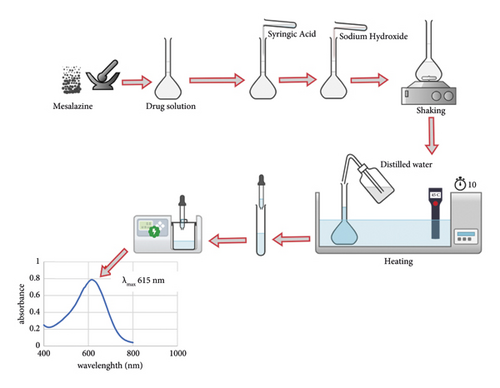
2. An Experimental Setup
2.1. Apparatus
A UV-visible spectrophotometer (UV-Visible Spectrophotometer AE-S60) controlled by computer software (MetaSpec) was used. 1.0 cm matched quartz cells were used for the measurements. A thermostatically controlled water bath (Lab. companion shaking BS-11, Korea) was used for the reaction heat control. Centrifuge 6000 rpm (SLAB, Germany) was used to separate the blood samples’ serum.
2.2. Materials
All solutions were prepared with analytical grade chemicals and distilled water. Chemicals (suppliers) were as follows: The standard of MSZ (purity: 99.9%) was obtained from Awamedica. Commercial samples (Pentasa 500 mg, Mesacol 400 mg, and Metaza 500 mg) were obtained from local pharmacies.
2.3. Preparation of Reagents and Solutions
A stock solution of 1000 µg·mL−1 mesalazine (MSZ), 0.05 mol·L−1 syringic acid (SA), and 1 mol·L−1 sodium hydroxide solutions were prepared. All pure reagents are purchased from Sigma-Aldrich, Germany. Standard solutions were prepared as required by dilution [30].
2.4. Sample Preparation
2.4.1. Pharmaceutical Preparations of Mesalazine
20 tablets of each commercially available drug were weighed, powdered, and thoroughly combined [31]. Each one contains either 500 or 400 mg of mesalazine was finely blended, mixed thoroughly, and weighed precisely. With gentle heating, the drugs were dissolved in distilled water, and after the solutions had been filtered, the concentration of mesalazine was brought up to 500 µg·mL−1 by adding distilled water in a volumetric flask.
2.4.2. Spike Human Blood Serum
Spiking human blood plasma is a laboratory technique used to add a known substance to a sample of human blood plasma for testing or calibrating analytical instruments [32]. Blood samples were collected from healthy individuals who were not receiving mesalazine-containing medications. The blood was allowed to clot before being centrifuged at 4000 rpm for 15 minutes to separate the serum. Then, 50 μL of serum was put straight into a 50 mL volumetric flask and diluted to the desired concentration with deionized water.
2.5. General Procedure of Indophenol Reaction
In the study, we accurately measured and transferred mesalazine (MSZ) to 10 mL volumetric flasks. These flasks allowed for dilution of the MSZ solution to obtain concentrations ranging from 1.25 to 50 µg·mL−1 for quantitative analysis. 3 mL of syringic acid (0.05 mol·L−1) was added to each flask containing the drug, which was made alkaline by adding 1 mL of NaOH (1 mol·L−1), and the mixture was vigorously shaken for 30 seconds in the presence of dissolved oxygen. The solution was then diluted with DW and heated for 10 min at 45°C in a water bath to complete the blue color of the indophenol formation reaction.
3. Results and Discussion
3.1. Oxidative Coupling of MSZ
When mesalazine is exposed to dissolved air oxygen and a base medium, it reacts with a syringic acid solution to make a blue color with the maximum absorbance at 615 nm. Figure 2 shows the absorption spectrum of the blue dye. The proposed mechanism for the hydrolysis of mesalazine to form the dye in the alkaline medium with syringic acid is shown in Figure 3. 3-Imino-6-oxocyclohexa-1,4-diene-1-carboxylate is oxidized by dissolved ambient oxygen, which reacts at one of the active sites due to an electrophilic attack to produce an indophenol dye as a result of the oxidation coupling reaction.
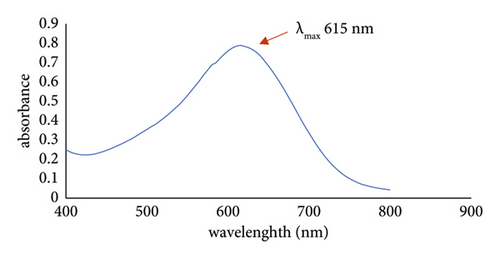

3.2. Optimization of the Experimental Condition of Indophenol Dye Formation
3.2.1. Effect of Bases Type and Its Quantities
The process of indophenol formation occurs under alkaline conditions [33]. Various types and concentrations of bases, including NaOH, KOH, Na2CO3, and NaHCO3, were investigated for the proposed oxidative coupling reaction. Sodium hydroxide was found to produce the highest color intensity, as illustrated in Figure 4. To attain heightened sensitivity, different volumes of 0.5 mol·L−1 NaOH were assessed, and it was observed that 1 mL produced the most significant absorption, as demonstrated in Figure 5.
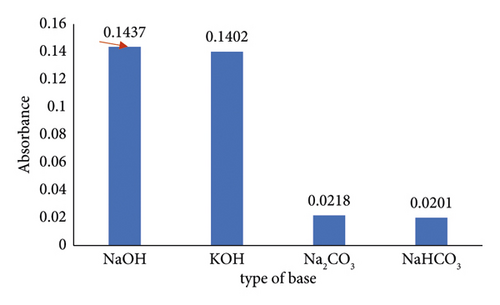
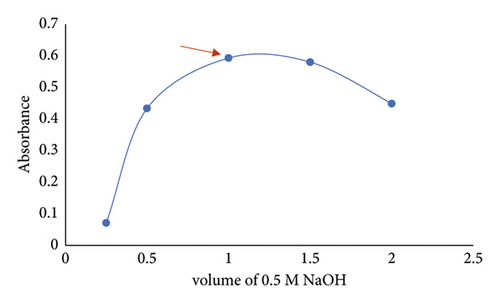
3.2.2. The Effect of Syringic Acid Solution Concentration
We could ascertain the ideal dosage by manipulating a single experimental parameter while keeping the remaining parameters and drug quantity constant. Specifically, we investigated the impact of varying the concentration of the syringic acid (SA) solution. As illustrated in Figure 6, our results indicate that the maximum color intensity is achieved at a concentration of 0.012 mol·L−1 for the SA reagent.
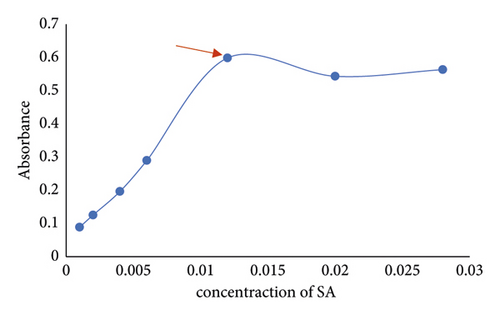
3.2.3. Effect of Temperature and Time
To determine the reaction time, we monitored the color development within a thermostatically controlled water bath at room temperature. Our results indicate that the highest sensitivity was achieved after 10 minutes at 45°C, as observed through the data presented in Figure 7.
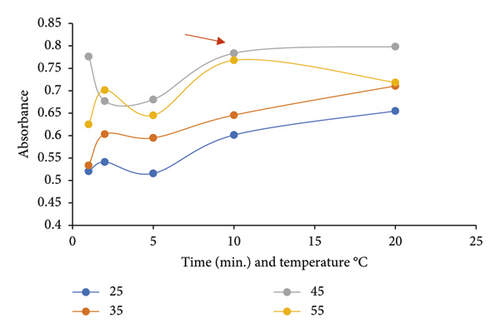
3.2.4. Stability of the Product
To ensure the stability of the generated indophenol dye, stabilizing agent, including Cu(II), was added, as some studies have reported that indophenol dyes can be unstable and show a continuous decrease in absorbance over time after reaching their maximum values [34, 35]. However, our synthesized dye exhibited exceptional stability, as depicted in Figure 8, with absorbance measurements reaching a maximum after only a few minutes and maintaining stability for 120 minutes.
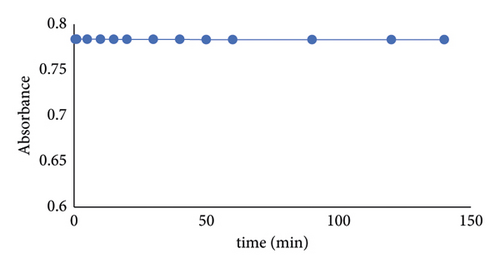
3.3. Method Validation
We assessed the suggested approach regarding linearity, sensitivity, precision, and accuracy.
3.3.1. Linearity
Employing the previously mentioned spectrophotometric methods, we obtained linear regression equations and graphed the information to investigate the connection between color intensity and mesalazine concentration from 1.25 to 50 µg·mL−1. The resulting regression charts displayed a linear relationship. In addition, the calibration data’s coefficient of determination, intercept, and slope were determined. We also computed the sensitivity parameters, such as Sandell’s index and molar absorptivity, along with the limits of detection (LOD) and limits of quantitation (LOQ) based on the parameters outlined in Table 1.
| Parameter | Values |
|---|---|
| λmax (nm) | 615 |
| Beer’s low limit (µg·mL−1) | 1.25–50 |
| Molar absorptivity (L·mol−1·cm−1) | 0.53 × 104 |
| Sandell sensitivity (µg·cm−2) | 0.068 |
| LOD (µg·mL−1) | 0.093 |
| LOQ (µg·mL−1) | 0.282 |
| Intercept | 0.3087 |
| Slope | 0.0145 |
| Coefficient of determination (R2) | 0.9993 |
Table 2 presents the calculations for both intraday and interday precision. The intraday precision assessment was conducted on the same day, while the interday precision assessment was performed through three days.
| Drug | Concentration (µg·mL−1) | Intraday precision | Concentration found (µg·mL−1) ± SD, RSD | ||
|---|---|---|---|---|---|
| Interday precision | |||||
| Day 1 | Day 2 | Day 3 | |||
| MSZ | 10 | 9.939 ± 0.7, 0.61 | 10.17 ± 1.7, 2.7 | 10.33 ± 3.3, 1.5 | 9.86 ± 1.4, 4.45 |
| 20 | 19.768 ± 1.2, 1.16 | 20.2 ± 1, 2.07 | 20.23 ± 1.15, 0.61 | 19.7 ± 1.5, 2.03 | |
3.3.2. Accuracy and Precision
To assess the accuracy and precision of the proposed method, three replicates were performed on the pure drug at each of the two MSZ concentration levels within the linear range (10 and 20 µg·mL−1). The results presented in Table 3 indicate that the method achieved high levels of accuracy and precision with relative errors and RSDs not exceeding 1.5%. These findings demonstrate the high reliability and repeatability of the proposed procedure.
| Concentration (µg·mL−1) | Recovery (% ± RSD) ∗ | |
|---|---|---|
| Proposed method | 10 | 99.39 ± 0.61 |
| 20 | 98.84 ± 1.16 |
- ∗Average of three replicates for each concentration.
3.3.3. Effect of Interference
We determined that interferences had no discernible effect on the product’s composition, as evidenced by the data presented in Table 4. Specifically, we analyzed synthetic sample solutions containing 20 µg·mL−1 of mesalazine and 75 µg·mL−1 of each excipient. According to our spectrophotometric measurements, the untreated samples exhibited no absorption under the experimental conditions observed. Notably, even at high concentrations, diluents, and additives, such as sodium chloride, lactose, starch, and glucose, did not interfere with the analysis.
| Interference | Recovery % |
|---|---|
| NaCl | 101.21 |
| Starch | 98.99 |
| Glucose | 98.57 |
| Lactose | 102.7 |
3.3.4. Application to Pharmaceutical Formulations
The spectrophotometric method for determining MSZ as a tablet and Pentasa suppository in commercial pharmaceutical formulations has been effectively evaluated without interference from excipients. This method uses regression equations to compute the MSZ concentration, and the mean recovery values obtained ranged between 98.98% and 101.7% with a low deviation of 0.06–0.14%, as shown in Table 5, indicating that the suggested method was highly effective.
| Pharmaceutical preparation | Certified value (mg) | Recovery (%) | RSD% |
|---|---|---|---|
| Pentasa (500 mg/tablet) | 497.9 | 101.7 | 0.14 |
| Mesacol (400 mg/tablet) | 401.7 | 100.60 | 0.58 |
| Metaza (500 mg/tablet) | 476.89 | 98.95 | 0.06 |
| t-test = 0.111 | |||
| F-test = 0.897 | |||
To ensure the reliability of the results, the outcomes of the suggested method were compared with the reference method [22]. Using statistical tests such as Student’s t-test and a variance ratio F-test at the 95% confidence level with four degrees of freedom, as mentioned in Table 5, the results of the statistical tests showed that the suggested method performs with sufficient reliability when used with authentic samples.
3.3.5. Application for Blood Serum
To verify the effectiveness of the proposed method [36], recovery experiments were carried out by adding 2 and 10 µg·mL−1 of MSZ. Table 6 shows the recovery results. The results of the proposed method prove the effectiveness of its accuracy and in recovering data from a serum blood sample. The recovery rates ranged between 97.00 and 103.00% demonstrate that the proposed method can recover most of the data from a serum blood sample, thus proving its effectiveness and providing a reliable solution for data recovery.
| Samplea | Add MSZ (µg·mL−1) | Found MSZ (µg·mL−1) | Recovery % |
|---|---|---|---|
| — | 10.08 ± 0.317 | — | |
| 1 | 10 | 9.98 ± 0.103b | 99.00 |
| 2 | 10 | 9.82 ± 0.44 | 97.42 |
| 3 | 10 | 9.82 ± 0.88 | 97.42 |
| 2.33 ± 0.17 | — | ||
| 1 | 2 | 2.42 ± 1.07 | 103.8 |
| 2 | 2 | 2.36 ± 0.46 | 101.1 |
| 3 | 2 | 2.37 ± 0.67 | 101.7 |
- aObtained from the blood bank of the PAR hospital, Erbil City, Iraq. bMean of three experiments ± standard deviation.
The proposed method was efficient when compared with well-known published methods based on Schiff base, charge transfer, diazonium, and other oxidative couplings. Table 7 reveals that the proposed method’s RSD, LOD, and LOQ show an acceptable range for specificity and sensitivity when compared with a recent spectrophotometric method.
| Reference | λmax (nm) | Type of reaction | Beer’s law (μg·mL−1) | LOD (μg·mL−1) | LOQ (μg·mL−1) | ε (L·mol−1·cm−1) | RSD (%) |
|---|---|---|---|---|---|---|---|
| [6] | 440 | Schiff ’s base | 50–500 | 0.699 | 1.84 | 3.744 × 102 | 0.00436 |
| [29] | 610 | Oxidative coupling | 0.1–11 | — | — | 2.055 × 104 | 0.714 |
| [8] | 640 | Diazotization and coupling | 1.25–30 | 0.14 | 0.483 | 0.36 × 104 | 0.17 |
| [37] | 459 | Oxidative coupling | 2.5–37.5 | — | — | 3.36 × 103 | 0.87 |
| [10] | 600 | Charge transfer | 15–97.5 | 4.92 | 14.89 | 1.18 × 103 | 0.890 |
| [11] | 645 | Oxidative coupling | 0.4–12 | 0.101 | 0.338 | 22435 | 1.54 |
| [12] | 687 | — | 15–50 | 0.5808 | 1.76 | 0.001958 | 0.4024 |
| [13] | 525 | Diazotization and coupling | 0.5–40 | 0.113 | 0.342 | 1.50 × 104 | 0.615 |
| Present work | 615 | Oxidative coupling | 1.25–50 | 0.093 | 0.282 | 0.53 × 104 | 0.61 |
However, the proposed method is more economical than other methods, only using dissolved oxygen as an oxidase agent for oxidation of MSZ to p-benzoquinonemomoimine, and the product is stable for a long time without using a stabilizing agent as in the determination of mesalazine by indophenol reaction.
4. Conclusion
The proposed method is simple, accurate, precise, and economical, in addition to being fast and requiring no extraction processes in advance. It is based on the oxidative coupling reaction of the analyte with syringic acid in the presence of dissolved oxygen, and the resulting compound was measured at 615 nm. When comparing the measured concentration to the theoretical one, the values from the Student t-test and the F-test were lower, indicating more accuracy and precision. Due to its high sensitivity, the suggested method appears to be well-suited for studying mesalazine in pharmaceutical formulations and plasma, as mentioned in Tables 5 and 6. The investigation of authentic samples containing MSZ demonstrated that the routinely used excipient did not interact. Hence, quality control laboratories may consider implementing these techniques to determine MSZ. The suggested approach presents considerable benefits, such as requiring only minimal reagents and streamlining the transformation process. The proposed method was efficient when compared with well-known published methods based on the Schiff base, charge transfer, diazotization and coupling, and other oxidative couplings. Table 7 reveals that the proposed method’s RSD, LOD, and LOQ show an acceptable range for specificity and sensitivity when compared with a recent spectrophotometric method. However, the proposed method is more economical than other methods, only using dissolved oxygen as an oxidase agent for oxidation of MSZ to 3-imino-6-oxocyclohexa-1,4-diene-1-carboxylate, and the product is stable for a long time without using a stabilizing agent as in the determination of other pharmaceutical formulations by indophenol reaction.
Furthermore, it seems ideally the proposed method suited for evaluating and guaranteeing the quality of mesalazine in commercial preparations, with little interference from commonly employed pharmaceutical additives that can be effortlessly eliminated. A developed bioanalytical method for serum blood samples was devised and validated using oxidative coupling of mesalazine with dissolved oxygen coupled with 4-hydroxy 3,5-dimethoxybenzoic acid in alkaline media.
Conflicts of Interest
The authors declare that they have no conflicts of interest.
Authors’ Contributions
Suzan T. conceived and designed the study, conducted the research, and wrote the manuscript. Diyar A. provided technical support for the research, provided critical insights and suggestions to improve the study, and helped revise the manuscript.
Open Research
Data Availability
The data used to support the findings of this study are included within the article.




